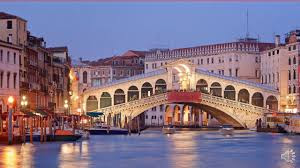An (in)secure world: how does climate change impact security?
I saw a tweet the other day, which led to
an article about how climate change induced shrinkage of Lake Chad has worsened
the humanitarian crisis in the area.
Today’s post is about climate change and security.
In what ways does climate change interact with security issues? What are the
security impacts of a sustained change in otherwise normal weather conditions?
Climate change has been said to be a threat
multiplier. A threat multiplier is something that amplifies or makes a certain threat
worse. It makes an already bad situation worse. It can act as a catalyst.
Extreme weather events worsen life conditions
because they directly destroy livelihoods, property, and infrastructure. They negatively
affect basic human needs. In Puerto Rico
power was knocked out in the entire country by Hurricane Maria. So much loss
and destruction was occasioned by the hurricane that Puerto Rico has to build everything
from scratch. This will require a lot of
resources which would have otherwise been used in development.
Below's a picture of residents receiving aid after the hurricane.
Embed from Getty Images
Below's a picture of residents receiving aid after the hurricane.
Most often than not, the shock of loss of property
and basic amenities at such a massive scale coupled with disaffection with the rate of response by authorities is
also likely to be a cause of breakdown in law and order and thus conflict.
This happens in the opposite scenario too. Long
drawn out droughts as a result of climate change would worsen conflict between
different groups that depend on the same resource. How? Basically, rainfall
supports life. Water is life. So if
there is not enough rainfall, surface and ground water recharge is affected
leading to resource scarcity and resultant conflict as everyone tries to get a
piece of it.
Here in Kenya, the Ewaso Ng’iro River literally is
the lifeline of the North Eastern part of Kenya. This area is populated by
pastoralist communities who depend on the seasonal rains for water and pasture
for their herds. The river supplies water for most of the year when it is dry. But
because of climate change, the amount of rainfall is inadequate and unreliable
hence the river is becoming smaller and the volume of water is reduced
drastically. This leads to conflict between different communities which rely on
the now scarce river water for life. Yes life itself.
The River Nile is another example, a shared water
resource supporting millions of people in the 11 countries it drains. It arises
in Lake Victoria and is also fed by the Blue Nile which arises in Ethiopia.
Climate change has been shown to be affecting all these countries and is
predicted to affect the variability of the Nile’s output.
The Nile for example powers Egypt’s agriculture and
ensures the country’s food security and economy by extension.
Conflict would likely arise because of problems
sharing this resource which is increasingly affected by global warming.
Food is the most basic human need. As with oxygen, one
cannot live without food. When climate change extreme weather leads to failed
harvests over and over again, the food security of a given area or country is
affected. Scarcity of food items leading to higher prices and/or inadequate
measures to address this will result to discontentment and possible political
upheaval.
Let me digress a little. When we talk of climate
change negatively affecting the ability of a person to earn a livelihood, we
are talking of people’s lives. About human dignity. How a person’s ability to
feed his/her family, give the kids a good education, build or buy a home is
affected. Basically we are talking about how your ability to lead a good life
is negatively impacted.
In North Africa, in countries like Mali, Chad and
Niger, global warming has led to the drying out of hitherto arable lands that
local communities depended on for farming or grazing as a way to get ahead in
life. Because the land is unyielding for lack of rain, this discontentment
feeds into the already volatile situation in the region. It adds to already
existing conflict and produces ripe ground for the influence of armed groups such
as Boko Haram, and the Tuareg Revolt.
It is basic human nature to desire a good life. We
all want a good life. As human beings, we are wired to survive, and to fight
for survival. As a result, when compared to the hard conditions caused by
climate change back at home, many young people in these countries are attracted
by the prospects of a good life in Europe and some begin the perilous journey
to get there.
Migration results into a clash of different
cultures, stress on available resources, social upheaval and hence conflict.
Due to the unpredictable nature of climate change,
extreme weather events cannot be fully anticipated. They however cause massive
destruction as is the case of flooding and mudslides in Sierra Leone in August 2017 which was caused by torrential rains and made worse by ecosystem
destruction. When the resultant displacement occurs, the authorities are
usually overwhelmed and unable to cope with the demand to take care of the
affected persons.
The conditions under which displaced or affected
people live in are most oft than not below par and provide an avenue for people
to engage in crime, with vulnerable groups such as women and girls worst
affected.
The frustrations occasioned by the sudden massive
loss and perceived slow response by responsible authorities to such
humanitarian crises made worse by climate change could also result to conflict
and political upheaval.
Another way climate change causes or aggravates
conflict is as a result of rising sea levels. High temperatures cause sea water
to expand and also cause polar ice to melt. This adds to the volume of water in
the oceans. Sea level rise is a threat to seaside cities as well as communities
that rely on the sea for a livelihood. Island countries such as those in the
Pacific are well-nigh in the direct path of such effects.
Extreme weather events such as hurricanes and sea
level rise directly result in destruction of property and infrastructure. They
cause massive financial loss. They can also destroy military bases directly
impacting the ability of a country to defend itself from external threats. Sea
level rise also affects international maritime boundaries becoming a source of
potential conflict.
Climate change has been said to have contributed to the Syrian conflict and the
resultant migration.
As I said earlier, climate change compounds already
existing conflict. Or it acts as the spark.
The good news is that it’s not all gloom and doom.
There is hope in climate optimism. We can be positive minded about climate
change. Early prediction of extreme weather events as well as increased
momentum in climate resilient development means that we can not only fight
climate change but also benefit from acting.
It is imperative that we put structures in place to
be able to identify and manage risks instead of reacting to climate change
induced disasters.
It is also of utmost importance to immediately
increase our efforts to vastly reduce the amount of greenhouse gases released
into the atmosphere.
The ability of a species to survive is highly
dependent on its ability to adapt to a changing environment. So I believe we as
the human race are highly innovative and will find ways to overcome climate
change.
But first of all we must sit down, agree, come to a consensus
then move forward together. The first step to solving a problem is to
acknowledge it exists.
Young people are the future of this planet both
metaphorically and literally speaking. Because of the highly globalized nature
of today’s world, we don’t see physical boundaries as limits any more.
Millenials are easily the most social and highly diverse age group in the
world. We are able to break the mold, we see ourselves as citizens of Earth
rather than belonging to a particular country.
This ability to think global is what I see as the
core of a youth led movement in climate action. We can be the change we need.
But for us to begin, we first need to understand the
issue at hand.





Comments
Post a Comment